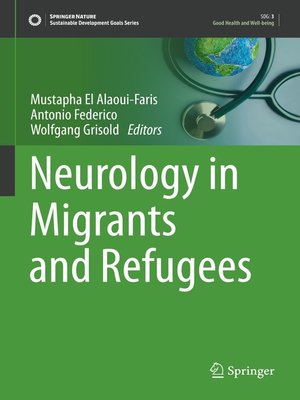Neurology in Migrants and Refugees
ebook ∣ Sustainable Development Goals Series
By Mustapha El Alaoui-Faris

Sign up to save your library
With an OverDrive account, you can save your favorite libraries for at-a-glance information about availability. Find out more about OverDrive accounts.
Find this title in Libby, the library reading app by OverDrive.



Search for a digital library with this title
Title found at these libraries:
| Library Name | Distance |
|---|---|
| Loading... |
This book is the result of reflections and work of the Specialty group on neurology in migrants of the World Federation of Neurology. The volume provides a synthesis of migrants' health in relation to the sustainable development goals and the 2030 agenda, and an up-to-date overview on neurological diseases among migrants, refugees and ethnic minorities.
The book is composed of both general chapters dealing with the history of migration, the relationship between climate change and migration flows, the migration and neurosciences research and the barriers to migrant's health. Other chapters deal with the migrants' particularities of the common neurological diseases such as cerebrovascular diseases, epilepsy, dementia, movement disorders, multiple sclerosis, headache, functional and mental disorders. In addition, also neurological manifestation of COVID-19 in ethnic minorities and palliative care in migrants are discussed.
Neurology in Migrants and Refugees will be useful to neurologists worldwide who can find appropriate knowledge for diagnosis and treatment when facing migrants with neurological disorders which are sometimes difficult to assess in the absence of clinical experience with the migrant population. It will also be very useful for international organizations, policymakers and non-governmental organizations working in the field of health and migration.
This book will certainly find an indispensable place in neurological departments libraries and will constitute a basic textbook for teaching neurology taking into account ethnicity, culture and health inequalities in the care of neurological disorders.
The book is composed of both general chapters dealing with the history of migration, the relationship between climate change and migration flows, the migration and neurosciences research and the barriers to migrant's health. Other chapters deal with the migrants' particularities of the common neurological diseases such as cerebrovascular diseases, epilepsy, dementia, movement disorders, multiple sclerosis, headache, functional and mental disorders. In addition, also neurological manifestation of COVID-19 in ethnic minorities and palliative care in migrants are discussed.
Neurology in Migrants and Refugees will be useful to neurologists worldwide who can find appropriate knowledge for diagnosis and treatment when facing migrants with neurological disorders which are sometimes difficult to assess in the absence of clinical experience with the migrant population. It will also be very useful for international organizations, policymakers and non-governmental organizations working in the field of health and migration.
This book will certainly find an indispensable place in neurological departments libraries and will constitute a basic textbook for teaching neurology taking into account ethnicity, culture and health inequalities in the care of neurological disorders.







